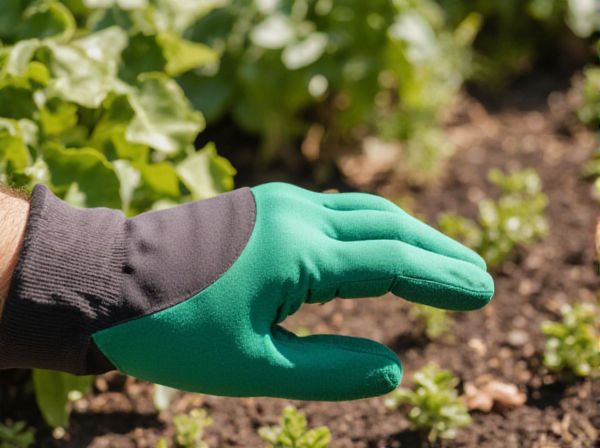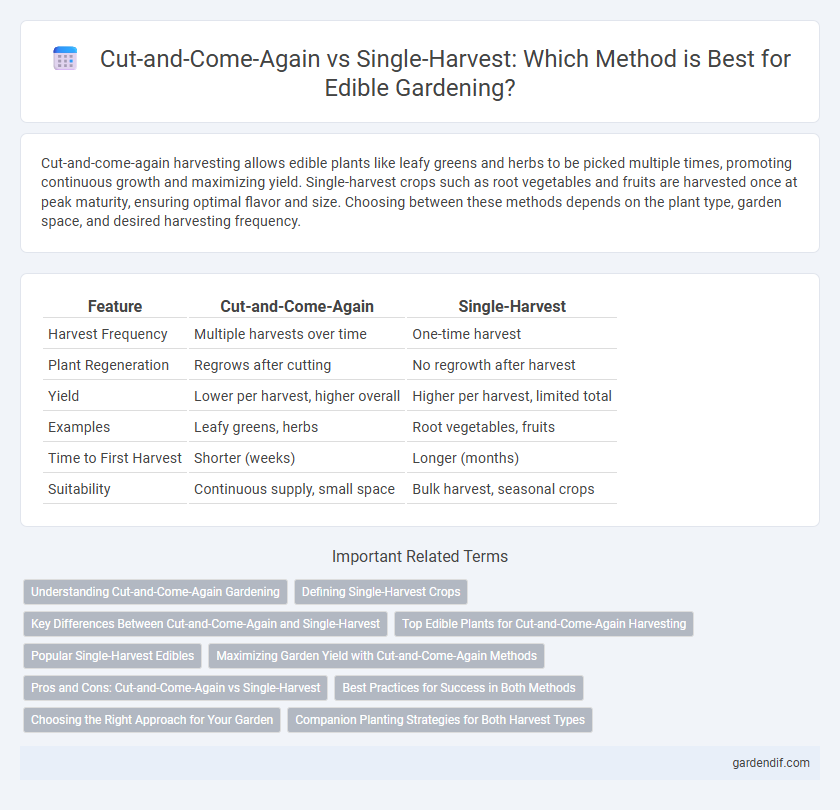
Cut-and-Come-Again vs Single-Harvest Illustration
Cut-and-come-again harvesting allows edible plants like leafy greens and herbs to be picked multiple times, promoting continuous growth and maximizing yield. Single-harvest crops such as root vegetables and fruits are harvested once at peak maturity, ensuring optimal flavor and size. Choosing between these methods depends on the plant type, garden space, and desired harvesting frequency.
Table of Comparison
| Feature | Cut-and-Come-Again | Single-Harvest |
|---|---|---|
| Harvest Frequency | Multiple harvests over time | One-time harvest |
| Plant Regeneration | Regrows after cutting | No regrowth after harvest |
| Yield | Lower per harvest, higher overall | Higher per harvest, limited total |
| Examples | Leafy greens, herbs | Root vegetables, fruits |
| Time to First Harvest | Shorter (weeks) | Longer (months) |
| Suitability | Continuous supply, small space | Bulk harvest, seasonal crops |
Understanding Cut-and-Come-Again Gardening
Cut-and-come-again gardening enables continuous harvesting by trimming outer leaves or shoots, promoting regrowth without uprooting the plant. This method maximizes yield from leafy greens like lettuce, spinach, and kale, offering fresh produce over an extended period compared to single-harvest crops. Understanding the ideal timing and technique for cutting ensures healthy plant recovery and sustained harvest quality in edible gardening.
Defining Single-Harvest Crops
Single-harvest crops are plants harvested once at full maturity, maximizing flavor and nutrient density in a single yield. Unlike cut-and-come-again varieties that allow multiple harvests over time, single-harvest crops require more space and time but often produce larger, more uniform produce. Examples include root vegetables like carrots and beets, as well as fruits such as pumpkins and melons, which are ideal for farmers seeking a singular, high-impact harvest.
Key Differences Between Cut-and-Come-Again and Single-Harvest
Cut-and-come-again crops, such as lettuce and spinach, allow multiple harvests by repeatedly cutting portions while the plant continues to grow, maximizing yield over time. Single-harvest crops like carrots and pumpkins require harvesting the entire plant once, often resulting in a larger single yield but no further production from the same plant. This key difference impacts gardening strategies, with cut-and-come-again favoring continuous fresh supply and single-harvest suited for crops requiring full maturity before picking.
Top Edible Plants for Cut-and-Come-Again Harvesting
Cut-and-come-again harvesting maximizes yield from leafy greens like kale, spinach, and Swiss chard by allowing multiple harvests from the same plants. These edible plants regenerate quickly after cutting, providing continuous fresh produce over weeks, unlike single-harvest crops that require replanting after each harvest. Choosing top cut-and-come-again varieties enhances garden productivity and reduces waste, making them ideal for sustainable edible gardening.
Popular Single-Harvest Edibles
Popular single-harvest edibles such as pumpkins, melons, and sunflowers deliver a one-time, abundant yield typically harvested at peak ripeness. These crops require full maturation before consumption, offering concentrated flavors and maximum nutrient density in a single collection. Unlike cut-and-come-again varieties, single-harvest edibles often demand longer growing periods and dedicated space but provide a robust, high-quality harvest ideal for fresh use or preservation.
Maximizing Garden Yield with Cut-and-Come-Again Methods
Cut-and-come-again harvesting techniques significantly boost garden yield by allowing multiple harvests over a growing season from the same plant, unlike single-harvest crops that are removed entirely at once. Leafy greens such as lettuce, spinach, and kale thrive under cut-and-come-again methods due to their rapid regrowth and continuous leaf production. Optimizing soil nutrients and consistent watering further maximize productivity, making this approach ideal for gardeners seeking sustained edible harvests.
Pros and Cons: Cut-and-Come-Again vs Single-Harvest
Cut-and-come-again edible plants offer continuous yields by allowing multiple harvests from the same crop, reducing replanting time and maximizing productivity. Single-harvest crops provide a larger, often more uniform yield in one go, simplifying harvesting and reducing labor. However, cut-and-come-again systems may require more frequent care and management, while single-harvest crops risk total loss if affected by pests or weather before harvest.
Best Practices for Success in Both Methods
Cut-and-come-again harvesting requires careful timing to ensure plants regenerate quickly, with frequent, light harvesting encouraging continuous growth and preventing stress. Single-harvest crops demand optimal spacing and nutrient management to maximize yield at once, focusing on plant maturity and minimal damage during harvest. Both methods benefit from consistent watering, adequate sunlight, and soil health monitoring to support plant resilience and productivity.
Choosing the Right Approach for Your Garden
Cut-and-come-again harvesting allows gardeners to enjoy multiple yields from leafy greens like lettuce and spinach by clipping outer leaves while leaving the plant to regrow, maximizing garden productivity. Single-harvest crops such as root vegetables and mature fruits offer a one-time, full crop harvest that requires less frequent maintenance but limits overall yield per planting. Selecting the right approach depends on crop type, available garden space, and desired harvest frequency, optimizing both growth cycles and food output.
Companion Planting Strategies for Both Harvest Types
Cut-and-come-again edible plants like kale, spinach, and herbs benefit from companion planting with nitrogen-fixers such as beans and peas, enhancing soil fertility for continuous harvesting. Single-harvest crops including carrots, beets, and corn thrive alongside deep-rooted companions like onions and garlic, which deter pests and improve overall crop health. Integrating diverse companion plants tailored to each harvest type maximizes yield, pest resistance, and nutrient cycling in edible gardens.
Cut-and-Come-Again vs Single-Harvest Infographic

 gardendif.com
gardendif.com